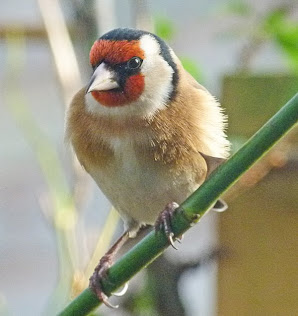Back in June 2008 all was not well on our allotment site.
It started with a report of strange curly, fern like leaves on the tomato plants in the polytunnel of one plot holder.
 |
| Tomatoes- fern like growth |
 |
| Potatoes - fern like growth and leathery cupped leaves |
We soon realised that all of the effected plots had bought manure from the same source and so suspected that the manure was the problem. I then started scouring the Internet for any information or confirmation of our suspicions. I eventually came across a post from the RHS asking for anyone who thought they had problems caused by manure to get in touch. I did and our case confirmed the RHS suspicions as we were the first to contact them having several 'gardens' displaying the same symptoms after obtaining manure from the same source. We had extensive 'conversations' with the RHS and it appeared that our problem was linked to use of a hormonal weedkiller containing aminopyralid - ForeFront. This was being used contrary to the way stipulated meaning that the contamination was getting into manure supplied to us gardeners.
 |
| Runner beans -Leaves thick and leathery with pronounced veins which tend to run parallel. Leaves cupped like a spoon. |
 |
| Peas - cupped leaves |
 |
| Runner beans - stunted growth, new growth fern-like, leathery cupped leaves,with prominent parallel veining |
 |
| Broad beans - cupped leaves |
 |
| Broad beans - cupped folded leaves , few flowers setting |
 |
| Tomatoes |
Then last week I received this email which I reproduce with Ann's permission:
Hi Sue,
I can imagine that by now you must have had more than enough of this issue, but as you were so amazingly helpful in 2011, I thought I'd at least let you know that we've been hit by this horrible poison yet again.
This time it has affected our community growing project: Edible Mach. We are part of the greater Incredible Edible Network and as part of our work this year we have created a Show Allotment in the heart of our town; Machynlleth. All went well until a couple of weeks ago when I spotted a familiar distortion of the growth on the broad beans. My heart sank as I realised it was Aminopyralid again. We bought in 8 tonnes of peat free compost and that is what we traced it back to. This compost gets made in part by what is put in the green waste stream, so it is probably Clopyralid, rather than it's evil big sister; Amino.
I'm hoping it will not get too bad, but worse case scenario would be that all our growing sites will be affected (12 of them, all over the town), as all had a top dressing of this compost. We are now gearing up for the fight with the supplier, who we paid £800 for this compost and who is trying hard to deny any responsibility. Would you be able to tell me if Trading Standards are any use in this kind of scenario?
We're hoping to give a lot of publicity to the issue once again, as we will have an official opening of the allotment with the press there and hopefully Incredible Edible will help too. There have been other incidences around the area as well this spring and for our market garden, this is the third time we've been hit in 6 years, despite all the precautions we now take, so clearly this problem is not going away. Maybe we need another pin in the map?
All the best and your allotment is looking amazing!
Ann Owen
It's bad enough when it affects us home growers but for Ann this is the second time her business has been hit.
It is at this time of year when cases of contamination are spotted and if it affects a gardener in isolation it is easy to blame something else for the aberrations. This year you could easily blame the weather. If you do suspect that you have used contaminated materials, make a fuss and go back to your supplier.
If you want to learn more my section on manure contamination is on my website here but be warned some of it is just transcripts of conversations and not for the faint-hearted. There are plenty more photos though too.
Footnote:
I have since found out that clopyralid is an ingredient in Lawn Clear, Weedol Lawn Weedkiller and Green Up Lawn Feed and Weed. (There may be more).
Also there are other hormone type weedlillers including 2,4-D, mecoprop-P, MCPA and dicamba which may have the same problem. Make sure that you read lables on weedkillers carefully.


































Thanks for this post. it is the first I have heard of this and your photos are really clear.
ReplyDeleteGill
I hope you never see this first hand Gill.
DeleteIt's so very frustrating. People dump any old thing in the green waste bin thinking the problem will just go away. And it's very hard to avoid bringing in compost and manure from unknown sources. I stopped buying the council's compost a few years ago, but as you say, the green waste is getting into everything it seems.
ReplyDeleteThe problem with green waste, CJ is that even if the,green waste isn't contaminated by its very nature is an inconsistent ingredient.
DeleteOh ! This is maddening considering how much money , time and effort we put into propagating our seeds !
ReplyDeleteIt seems gardeners have little comeback in these sort of events, Debs.
DeleteA superb review Sue although you are a bit coy about your actual source, It would appear to be a problem both due to commercial potting compost and stable gate and perhaps farm sales of manure.
ReplyDeleteYour problem is not a new one. forty years ago a hormone weedkiller picloran caused similar problems
Most lawn weedkillers are hormone based and to a lesser extent than aminopyralid but still significant lawn weedkillers are recycled via the green bin.
I despair that use of green bin recycling leads to contaminated compost and that farm wastes cycle residues to manure
Morals are
1) Recycle your own organic waste and don't rely on farm manure from dubious sources - most sources in fact! Its such a shame that well made farmyard manure from clean sources is the very best bulky organic material to add to the garden (pity about the weed seeds )
2) Avoid composts made from recycled organic matter and look again at peat composts or consider making up your own composts from good soil or other alternatives.
Me coy - never! Which source am I being coy about?
DeleteUgh - I haven't yet had this issue and do use municipal compost in the beds and I don't make enough compost of my own (yet!), but in Canada, lawn weedkillers have been banned for residential use for about 6 years now. I think it's unlikely they'll end up in the compost bins at this point. However, I do think golf courses,etc., are still allowed to use them, so you really never know. It sort of irks me that commercial uses such as this are exempt...obviously playing a round of golf trumps people's health :(.
ReplyDeleteI believe several years ago clopyralid caused a problem for the US compost industry, Margaret.
DeleteOh, I am just sick reading about this. I can't imagine how devastating that would be to have happen.
ReplyDeleteIt was for us at the time, Sue as the whole thing was an unknown quantity. Now we no longer have a problem although for some people it takes years for the contamination to work through.
DeleteDevastating! I feel so sorry for you and anyone else affected by this; so much hard work undone by unscrupulous manufacturers. I did have something similar on my potatoes a few years ago; at the time, the RHS couldn't tell me what caused the fern like leaves so at least your post has solved that mystery. I haven't been affected since but don't use municipal compost anymore and my farm manure seems to be clean. I presume you'll have to burn all the affected crops?
ReplyDeleteAt least we have seen the back of it, Caro although we have had suspicions about some composts thar we have used. I do have the utmost sympathy for Ann though and feel angry thar all these years later things like this are still happening.
DeleteI am really surprised that the RHS couldn't help re your problem as they were fully involved when we had s problem and Guy Barter shared time on the piece that I did on Gardeners' World,
Thank you for highlighting this hideous problem once again and for all the time, effort and work you have been putting in behind the scenes.Isn't it awful? To think that green bin waste is now a problem, a neighbour of mine blames rust on her hollyhocks on council compost as she suspects people recycle that too....I wonder what else goes into green bins that causes issues...black spot on roses...the list is probably endless. What a shame we can't trust what was once a great scheme.xxx
ReplyDeleteIf it is done correctly in theory the processing carried out when composting green waste should kill off disease and weed seeds, Snowbird but who knows. We bring anything we don't want to compost home for the green bins as the council no longer provide a skip on site and discourage the use of fires. Fires are supposed to be lit one hour before dusk which at this time of year is almost bedtime!
DeleteThank you so much for warning people about it. I was considering getting some free compost from the city nearest to us but having read this, I will continue to rely exclusively on the compost we make - even if we could use a lot more. At least we know exactly what goes in.
ReplyDeleteYou maybe don't have the same issue in your part of the world, Alain.
DeleteOh dear! It's horrible! Hope your plants survive this problems....
ReplyDeleteWe are OK this year so far Malar
DeleteAn interesting post Sue. We have spread council compost on the flower beds in the front garden. I expect time will tell if that contains any weedkiller, interestingly the council haven't offered free compost for several years as they were sending it to a local organic grower. I wonder now if they discovered a problem x
ReplyDeleteOne of the problems is the definition of organic, Jo. Back in 2008 someone obtained contaminated manure form an organic farm so I looked into this my findings are here Things may have changed by now but the information was correcrt in 2008 and surprise me.
DeleteThe evidence from my garden shows me that the effects of these weedkillers last a lot longer than people would have us believe. Even the RHS says that it "should have dissipated by next season" (year?), but this is just not true. This year I am going to try hard not to put ANY material from affected plants into my own compost bins. It is so easy to forget and just put a few prunings in - which presumably just prolongs the problem. I have not bought any MPC this year and I have checked with Levingtons that their John Innes No.1 and No.2 do not contain any green waste.
ReplyDeleteI am surprisedhat the RHS said that! They talk in half life when they estimate the persistence of this contamination. It depends on the extent of contamination - after our problem we had volunteer potatoes coming up with distorted leaves for a few years. Just a tiny tuber overlooked perpetuates the problem. Also small fragments of plant debris can perpetuate the problem. I know some people who have been affected for several years after the initial contamination. Our contamination was caused by aminopyralid which is stronger than clopyralid used by gardeners but even so is designed to be effective and persistent.
DeleteSome gardening 'experts' were stating that you could flush out the residue which isn't possible. The problem was that they didn't have an understanding of how the ingredient works and that it becomes bound up inside the plant and is broken down by microbial activity. No amount of flushing out works. The heat treatment given by compost makers has no effect either.
Thinking of your suspicion that canes could be affected. Canes being hollow, I wonder whether some affected compost could have been pushed inside the cane and come into contact woth the soil again when pushed back in this year. Just a thought.
Hi Sue, I know several gardeners who use professional lawn treatment companies, do you know what their weed killers contain? Do they recommend not composting grass from treated lawns?
ReplyDeleteHi Brian,the research that I carried our was really focused on aminopyralid and clopyralid came up as having the same effect albeit at a lower level. Whilst weedkillers containing aminopyralid atr not allowed to be sold to domestic users I am not vertain that professional lawn sprayers can obtain it.
DeleteOne of the problems with the initial contamination was that contract sprayers did not pass information down the user chain and in our case, farmers were not aware of the need not to pass on manure etc from animals browsing fields sprayed.
Since my initial research I now know that other active ingredients on lawn weedkillers are hormonal but I don;t know how persistent they are. THE RHS produce a factsheet about weedkiller ingredients available to the domestic user Weedkillers for home gardeners. I would imagine that the range available to the professional user is more extensive.
If I was using a contract sprayer I would want to know which product they were using and ask to see the label and any information relating to its use.
Generally speaking ay least the first mowing after using most lawn weedkillers should not be composted. The RHS suggest using this as a mulch but I can;t see how this is any safer than composting. Further from that the manufacturer may suggest comp[osting for at least a certain period of time.
Sorry that this is a bit vague but its a minefield.
I've had this with my tomatoes this year, 2018, using JA Bowers Multipurpose compost.
ReplyDeleteSorry to hear this, Robert. It seems this scourge is going to be with us indefinitely. Did you contact the manufacturer?
Delete
ReplyDeleteThank you so much for your fantastic advice and insight! I am always looking to other gardening sites for information and inspiration!
Your site looks amazing and you provide huge value in the field of gardening!
Have an awesome sunny day!
Rick Smith
rick@inthegardenlife.com
https://inthegardenlife.com/